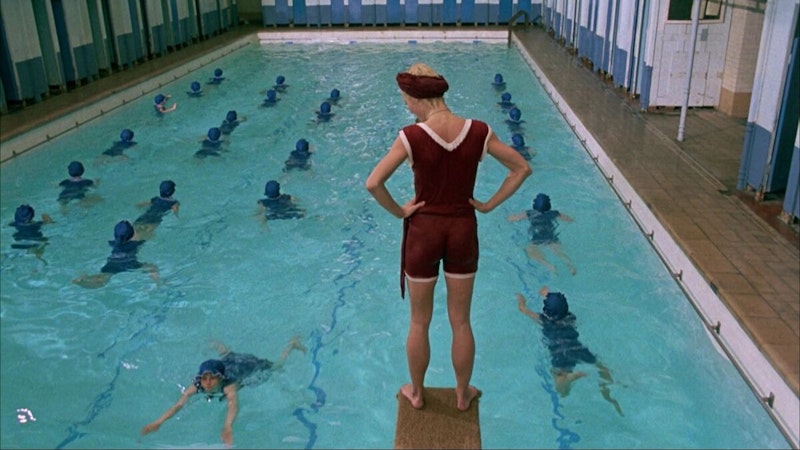The first great success in Ken Russell’s directing career came with his 1969 adaptation of D.H. Lawrence’s 1920 novel Women in Love. Twenty years later Russell returned to Lawrence, adapting The Rainbow, the 1915 novel to which Women in Love was the sequel. Lawrence originally saw the two books as a single work, but his publisher chose to release them separately. The five years between them came about largely because The Rainbow was poorly received and banned as obscene; half the original print run was destroyed by British magistrates.
That was catnip for Russell. But the mores of 1989 were very different from 1915, or even 1969. Russell, writing the adaptation with his wife Vivian, did expand the lesbian scenes that brought about the novel’s censorship, but the film still didn’t make much of an impact. You can understand why.
Russell was incapable of making a wholly conventional movie, but The Rainbow comes surprisingly close. He dispenses with most of the early parts of Lawrence’s generational saga to concentrate on the story of Ursula Brangwen (Sammi Davis), daughter of a well-off farmer, who dreams of art and is determined to make a life of her own at the dawn of the 20th century. The film opens with her as a child running after a rainbow, then moves forward briskly to her late-teen years. She has a relationship with her gym teacher (Amanda Donohoe), falls in love with a soldier, and tries to make her way in the world as a teacher of poor city boys. There are tensions with her family, a pregnancy scare, and, in the end, a final shot that bookends the film’s opening, as an older Ursula once again chases a rainbow across a green field.
Lawrence’s novel often shuns dramatic action in favor of long discursions on character, so Russell has to create some scenes of his own along with building on moments that Lawrence gives. There’s logic in expanding the lesbian relationship, and later Russell goes far enough to invent a bit with Ursula posing for a lecherous painter. But the schoolroom scenes are much as Lawrence described them, and the overall arc of events is roughly congruent to the book. For better or worse.
The book’s themes fit with the themes that Russell’s explored over his previous two decades of films. Sex, god, class, the injustice of war, the way that the system of society not only victimizes people but forces those victims to become tyrants themselves—these fascinate Russell. But his usual irony is restrained, and perhaps as a result the film never comes alive.
The too-cute opening shot and too-cute matching shot at the end come off as tonal mismatches to the rest of the work; the film is otherwise in a different register. In some of Russell’s better films, a sudden ironic swerve in the final seconds pulls the work together and suggests a new way of viewing what has come before. Here, Russell’s retreating from the implications of the rest of the movie. However ironic it might be, the ending’s bizarre after everything that Ursula’s gone through, negating whatever change we might imagine has come to her character.
It doesn’t help that sexual elements which might’ve been bracing in 1989 are now unexceptional. The movie’s depiction of queer sexuality reads to a contemporary viewer less as Russellian provocation than as someone doing a muted imitation of Ken Russell. For the most part, time has not been as harsh with Russell’s previous films; his movies have had a berserk quality of vision that doesn’t really age. But this movie’s anchored so thoroughly in cinematic realism that it’s much more difficult to see that distinct sensibility.
Russell, as always, is in command of his medium and creates the kind of visual palette he wants. The schoolhouse is filled with murky grays and browns we feel viscerally after the lush greens of Ursula’s family’s farm, and the bright red of her male lover’s army uniform lingers in the mind. The dingy day-to-day practicalities of life more than 100 years ago, the washbasins and the carving knives, have a tactile quality unlike the props of most period films. All this is good. And yet it resists building up to the wildness of most Russell movies.
There’s no characteristic Russell sequence in this movie that breaks away from realism. No fantasy sequence, no hallucination. There are a couple of orgasmic sex scenes, but they don’t have the effect of Russell’s usual bravura set-pieces. Lacking those, there’s a tension here from which we’re not released. Russell’s theme of power becomes narratively oppressive; there’s no escaping it, and this movie doesn’t give us much of a hint of redemption through art or God.
That exploration of power is at least handled well. The way Ursula is put into a position where she has to inflict violence on her students is meticulous and inevitable. The way it parallels the Boer War, and the way the British Empire molded boys to go off to war, again shaped by violence to commit violence, is clear. This is realism in the best sense, a dissection of society through a close examination of the individual experience.
But the irony Russell can’t help but bring to the project ends up despairing. Ursula chases rainbows, but whoever catches a rainbow? The movie’s quietly resigned in a way Russell usually isn’t. And it’s difficult to see what he gains in losing the exuberance and radicalism in form he usually brings. I don’t think that’s Russell mocking his source material but rather being overly reverential to it, which isn’t usually something Russell’s accused of. In that way, at least, he’s learned a new trick.

